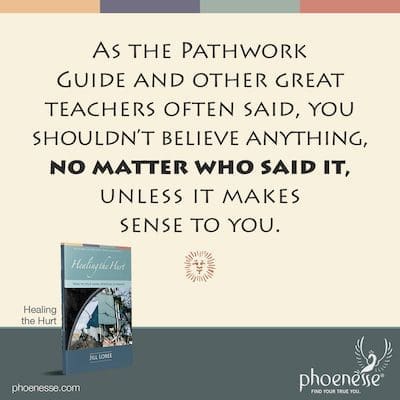- What is Pathwork®?
- Where the Teachings Come From
- Who is the Pathwork Guide?
- More About Pathwork Teachings
- How this Differs from Therapy
What is Pathwork®?
Pathwork is a lifelong spiritual path of self-discovery that helps us understand the workings of life. It also helps us heal our emotional wounds, and foster harmony and balance within our own being, as well as with others and God. Or at least that’s one way to say it, if one were to try to explain the Guide’s teachings using a handful of words. Which is crazy-hard to do.
Spilling the Script is my attempt to boil down and paraphrase the Guide’s teachings. Which is also an audacious undertaking if ever there was one. I was once told that I have a tendency to want to boil the ocean. And although that wasn’t meant as a compliment, the Guide tells us that under every fault is a gleaming jewel waiting to shine free. It is my hope that I have found a way to put my quirk to good use.

Where the Teachings Come From
The teachings of the Pathwork come from a collection of about 250 lectures. They were given in the 1950s, ‘60s and ‘70s by a Vienna-born New Yorker named Eva Pierrakos. Perhaps the least interesting thing to know about these lectures is that they were channeled. But there it is. This relevant-yet-insignificant fact is often among the first that tumbles out when one tries to explain the Pathwork.
It is a relevant point of interest because this material, of which there is a lot, is often of great interest to people who like to use their brains. The lectures are long—roughly 10–12 pages each—and it takes some mental stamina to get through them. (This is exactly why I have written the Real. Clear. spiritual book series, which paraphrase many of the Guide’s wonderful teachings into easier-to-read language.)
Such intellectually curious but also skeptical people are exactly the ones who are going to ask, “Where did this material come from?” as part of their discernment of whether or not it’s any good.
At the same time, it is insignificant, because who cares where it came from. As the Guide and other great teachers, including Buddha, often said, you shouldn’t believe anything, no matter who said it, unless it makes sense to you. In my own experience and discernment, the Guide’s teachings are unparalleled in their wisdom, scope and practicality. Also, in my own opinion and experience, the Guide’s teachings about how to help others are extraordinary in their effectiveness.
Who is the Pathwork Guide?
The Guide is the entity who is actually speaking, using Eva as the medium, or channel, through which he spoke. Owed to Eva’s dedication to her task as well as her willingness to do her own work, the material continually evolved and deepened over the course of the 22 years that she gave monthly lectures.
Note, in those days it was the literary convention to use masculine pronouns generically, but that is not why we say the Guide was a “he.” It’s more that people who were present during the lectures sensed the Guide as masculine, even though we know that at a certain level beyond our Earth sphere the masculine and feminine merge. For the sake of consistency and to avoid referring to the Guide as an “it,” we’ll proceed to speak of him respectfully—but loosely held—using the male pronoun.
More About Pathwork Teachings
Each month, for over 20 years, a small group of people would gather with Eva, who would go into a trance and begin to speak. It is my understanding that the lectures themselves were composed by a council of spirit beings. But if you listen to the tapes of Eva speaking, you can hear that they sound conversational—not like someone reading a prepared, prewritten lecture.
When you add this together with Eva’s less-than-perfect English—she was raised in Vienna, Austria—you can imagine that some editing was in order for the transcripts. During this work, in addition to creating complete sentences, the editors removed that masculine-pronoun convention to make the lectures more universally appealing. (I personally wish they had also been more liberal with the use of paragraph returns.)

To the deeper question about who exactly the Guide is, we don’t know. The Guide said that his name was not important, and that we should learn to trust our own discernment rather than rely on the reputation of the source as our reason for listening, trusting or believing. As you may know, the Guide was a big champion of this type of self-development.
After each prepared lecture, participants were encouraged to ask questions, which it seems the Guide himself answered. For this reason, the Q&As seem to carry a somewhat different vibe from the lectures, which, in addition to their shorter length, makes them a bit easier to digest. The Q&As were either related to the lecture just given, to a person’s personal issues or to life in general. Having read them all, I can attest that they offer a wisdom and perspective that has the potential to change your worldview.
The lectures, including the questions asked immediately following, were all recorded and are now available online in the form of printed transcripts, free audio recordings read by Gary Vollbracht, and, for a fee, the original recordings by Eva.
In addition to the questions asked following the monthly lectures, Eva and the Pathwork Guide would hold monthly Q&A sessions. I have sorted the thousands of questions into topics to make them more accessible, and they are all available for free reading at www.theguidespeaks.com.
But in none of these exchanges did the Guide really talk much about how to be a Helper, i.e., how to really apply the teachings and “do the work.” That was shared during private sessions and trainings. And that is the information handed down to me during my four years of Pathwork Helpership training. So the Guide is ultimately the one who taught what I am endeavoring to share here.
Pathwork is a trademarked word, owned by the Pathwork Foundation, a non-profit organization. It was coined along the way by Eva and other followers of the Guide based on the fact that he so often spoke of “being on a path,” and the reality that it is hard work to follow such a path.
In truth, every human being is on a path, whether we know it or not. Today, however, many more people are becoming conscious about the spiritual journey we are on. So we’re reading books by contemporary spiritual teachers, attending weekend workshops and weeklong retreats, learning about mindfulness, sitting in meditation, and taking yoga classes. My own spiritual journey began to deepen when I showed up at my first AA meeting in 1989. Sometimes newcomers struggle with the spiritual aspects of AA, but they are missing a key point: there is no spiritual part of AA—it’s a spiritual program.
In general, people today are ready for more. And many are realizing it’s hard work either way. It doesn’t matter whether one is consciously attending to life’s challenges and the opportunities for growth embedded in them, or bumbling along and hoping for the best. Whatever our approach, life is going to teach us our lessons. We can go kicking and screaming, or we can go about things in a better way.
Hard as it may be to look directly at our own faults and negativity, at some point, we realize that we just can’t keep looking away from ourselves and hope to find solutions. And that, in a way, is the heart of what the Guide teaches. The way to get to the other side of our dilemmas in life is by stepping through the gateway of self-responsibility.
Being a Helper, then, is about working with people who are ready to walk with consciousness, using these teachings as their guide, and face everything. This means the person doing the work, called the Worker in Pathwork vernacular, must indeed do the work. No one can do this work for us.
The Guide offers profound teachings but they are only valuable if they are put into the service of understanding and unwinding the everyday disharmonies—both large and small—of a person’s life. How this is done will be explored in depth as we go forward.
Suffice it to say for now, one has to actively apply the Guide’s teachings to be served by them. And as the Pathwork Guide often points out, no one can do this work by themselves. So all of us need some kind of helper in our lives. What an incredible gift we offer when we can be that for someone else.
How this Differs from Therapy
Generally speaking, the goal of therapy is to address a specific issue, i.e. deal with a painful relationship or divorce, handle the strain of aging parents, or cope with the stress of a difficult workplace environment. Or it may be to address and manage a particular problem such as depression, anxiety, bi-polar disorder or the like.
Our aim in doing the spiritual work of healing must also necessarily work with our life issues, but that is not the main goal. Rather, the intention here is to work with the daily occurrences of life to unravel their roots and transform blocked emotional pain back into the free-flowing energetic state from which it came. It is only when this has been done to a certain degree that the deeper purpose of walking a spiritual path can be experienced: to consciously surrender into a deep inner connection with the source from which all wisdom, love and courage arises, and which is the true birthright of every human being.
People embark on a spiritual path because they are ready. Their soul has reached out into the universe and landed just the right book in their lap, made just the right “coincidental” introduction, or brought just the right workshop past their nose. The Guide is clear that none of this is left to chance. When the student is ready, the teacher does appear.

So as Helpers, it is not to be taken lightly that someone has found their way to us. Of course, if we’re the kind of Helper who works in one-on-one sessions, this doesn’t mean our Workers will stick or that there won’t be challenges in the work. But it means that on some level of our beings, outside the bounds of our conscious awareness, we are entering into a sacred contract together. This should not be taken lightly. As Helpers, it’s important that we hold this aspect of our interaction in our awareness, especially with new Workers who may not be able to appreciate the greater holding of the work yet.
The more we study the Guide’s teachings, the more we come to realize the extent to which we are blind to what’s happening in our own selves. This is the human condition. As Workers ourselves, we Helpers have come to know that there is nothing more glorious on Earth than following a path of self-confrontation through which we come to terms with ourselves. Self-acceptance is the sole basis for growing, and once we achieve some measure of growth, we’ll discover a richness and fullness to life that can be hard to describe.
Fortunately, as Helpers, it’s not our job to describe it. Our job is to hold the already-healed wholeness of this precious individual sitting before us. Bit by bit, they will show us the shards they are sitting with, the fragments of their tortured soul that are longing to be healed.
In their fragmented state, they can’t access their own wholeness, but if we guide them in the right way, they’ll find their way to their own divinity. They’ll find their inner light that has gotten shattered and denied and hidden. That’s how we can help them heal. And if that’s what some people are doing in therapy today, God bless them.

Next Chapter
Return to Healing the Hurt Contents


